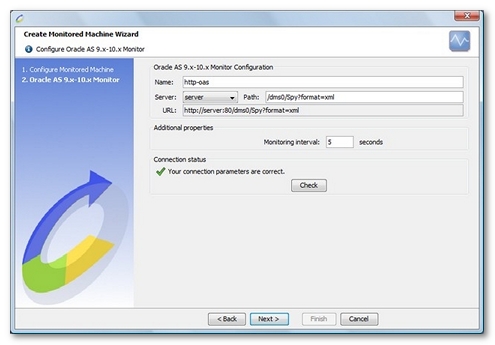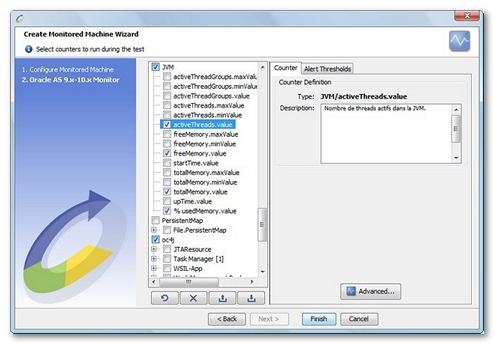Oracle Application Server 9.X-10.X
Configuration
To define the connection to an Oracle Application Server using this monitor requires that the DMS (Dynamic monitoring System) library be activated. By default, it is activated on OC4J (Oracle Container 4 Java) servers version 10g.
The following procedure can be used to make sure the server metrics are accessible through the DMS library:
- To test the DMS
- Launch an Internet browser from the machine on which NeoLoad is installed.
- Enter the following address: http://<server>:<port>/dms0/Spy?format=xml. <server> is the server hostname. <port> is the server port.
For example: http://oc4jserver.com:8888/dms0/Spy?format=xml.
- Check that the returned content is in XML format. The content should start with <?xml version='1.0'?>.
- In the event of an HTTP 404 (Not Found) error, repeat step 2 using this address: http://<server>:<port>/dmsoc4j/Spy?format=xml.
For more information about monitoring Oracle Application Server servers through DMS, refer to the Instrumenting Applications With DMS documentation in the Oracle website.
Supported versions
This monitor supports Oracle Application Server 9 and later.
Connection settings
Defining a connection to an Oracle Application Server requires a server (defined in the Server section of the Virtual Users) tab and a path. The server to be used can be created, or a server created during a recording can be used.
Create an Oracle Application Server 9.X-10.X monitor
NeoLoad makes it possible to create a new monitor either using the monitored machine creation wizard, as described in Create and configure a monitored machine, or from an existing monitored machine, as described in Create and configure a monitor.

NeoLoad displays a list of the EARs (Enterprise Archive) and WARs (Web Application archive) deployed on the configured server. It then automatically selects the most appropriate counters for each of the selected applications.

Available counters

The counter advanced settings are available for all the HTTP counters. See Advanced Settings.
The Oracle Application Server counters are automatically calculated based on all the available managed objects. As the list of Oracle Application Server counters is dynamic, calculating the total number of counters may take several seconds. For certain counters, a description allows access to its documentation. Here are some of the most common sections.
- JMS. Counters in this category contain information on JDBC connection pools. For example, the number of expired messages for each pool can be retrieved.
- JVM (Java Virtual Machine API). Counters in this category contain information on the Java Virtual Machine memory usage, including the total available memory and the size of the memory available for the JVM.
- oc4j. The sub-categories of this category are the EARs deployed on the server. For example, the number of requests processed for each EAR can be retrieved.